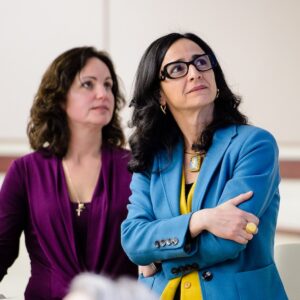LEGGI QUESTO ARTICOLO IN ITALIANO
The Reggio Emilia approach is a uniquely progressive method of education that has made its way from Italy into America, inspiring educators and parents alike. At a time in which standardization in public schools across the United States is becoming more prevalent, there is also an unfortunate withdrawal of art, music, theater, and other creative programs. This is of great concern, as the school system is sacrificing creativity in the name of uniformity and sameness. On the other hand, the Reggio Emilia approach has a significant focus on individualization, children’s interests and potential, and the use of art to innovate: it may thus be the light at the end of the tunnel in educational reforms.
On March 15, the Inserra Chair at Montclair State University presented a panel on the Reggio Emilia approach as part of its regular cultural programming. In introducing the event, Dr. Teresa Fiore, Inserra Chair, brought attention to the diversity represented on the panel: next to a school director, a teacher and a parent from a Reggio-inspired school in NJ (A Child’s Place), the audience had the opportunity to listen to Lella Gandini, renowned Reggio Children Liaison for the Dissemination of the Reggio Emilia Approach in the U.S.. The Reggio Emilia approach was founded soon after World War II by pedagogue and teacher Loris Malaguzzi, who believed in the innate ability and curiosity of children, as well as their involvement in the specific environment around them. Gandini introduced the fundamentals of the approach by quoting Malaguzzi: “One of our strong points has always been to start from an explicit declaration about the very open image of the child that we hold. What does that mean? That means an observation of the interaction of children with teachers, teachers who observe and learn from the children what their interests are.”

Through the story of 10-month-old Laura, Gandini provided the audience with a example of a Reggio-inspired lesson and displayed the importance of observation, documentation through notes and pictures, and the learning that occurs in a real-life situation.
Beautiful black and white pictures show Laura as she looks through a catalogue until she is struck by a page depicting watches. The teacher quickly thinks about showing Laura her own watch. Laura touches, observes, listens to the ticking – will she make a connection? Gandini then showed the audience a picture of Laura attempting to “listen” to the watches pictured in her catalogue by placing her head on the catalogue page, and concluded that Laura followed up the invitation of the teacher in trying to “generalize” the idea of watches.
“All children have something to teach to us.” Gandini added. “Including children with special needs, who are called in Reggio ‘children with special rights.’” The approach is so dynamic that practitioners and parents often wonder about the the inclusion of these children in the Reggio Emilia approach. Gandini was keen on specifying that in the schools based in Reggio Emilia, Italy: “Children with special needs are the first ones who are admitted because there is really a special attention to them. There is also a city-wide support. Of course there are very different needs, therefore a team of specialized pedagogical coordinators comes into play..”

Kathleen Berkowitz, School Director at A Child’s Place, commented on the development of Reggio Emilia in the U.S. from the perspective of her direct experience in a Reggio Emilia inspired school. She explained that teachers need the time to study, collaborate, discuss, plan, and reflect on their work while they listen to the children and observe them in order to make authentic assessments and to document their work to make the learning visible. While they receive support in professional development, they are expected to take risks within their exploration. They develop trusting relationships not only with their colleagues, but also with the parents, becoming partners in supporting and facilitating the child’s ideas and interests. As she incisively put it: “Children are not vessels to be filled; we want to provide them with environments that provoke thought and learning. Children are born curious.”
Perhaps the most important aspect of the Reggio Emilia approach is indeed the children and their abilities. Loris Malaguzzi once said that, “The child is made of one hundred. The child has a hundred languages, a hundred hands, a hundred thoughts, a hundred ways of thinking, of playing, of speaking.” With the Reggio Emilia approach, children can reach their full potential: exploring, creating, thinking, working together, and doing. Hearing Malaguzzi’s words from Lella Gandini herself was a highlight of the evening.
Debbie Piescor, Master Teacher at A Child’s Place, described a “day in the life” in a Reggio Emilia inspired school, discussing motives and philosophies of this approach. Even if a topic is the same from one year to the next, the experience is different because teachers learn alongside the children and continue constructing the curriculum in the process. She defined teachers as a researchers― “but not to get the exact answers to be fed to the children since this is not the value in the learning experience, but so that we have some idea of the potential that we can bring to help move their thinking forward.” When asked about the incorporation of the core curriculum standards, which is so central to the objectives of the U.S. system, she offered a balanced view: “We start with the learning experience and then are able to extract the standards from that.”
She added that there is much emphasis on the school environment as the “third teacher” (indeed the schools have an atelier, a piazza, a kitchen, an outdoors space). The significance of the environment in learning is the reason why the Reggio Emilia schools in Italy cannot be exactly duplicated here in America. Because of this, schools are called “Reggio Emilia inspired” in other places.

Piescor further explained: “It’s our job as the teachers to set up the environment in a way that provokes the children not only to learn how to learn, but to become self-motivated learners able to make new connections and discoveries with each other, on an independent basis and with the teachers.” Her video about students sharing different opinions about a found underground object in the school’s garden was very illuminating: is it a tree root, a dinosaur bone, or what else? Explanations based on nature observation and imagination made for a lively discussion among children.
Dr. Gina Miele, Professor of Italian at Montclair State University and informed parent at A Child’s Place School gives a different, yet very important, perspective on the approach. Her love for the Reggio Emilia approach has inspired her to incorporate some of the fundamental values into her classroom.“The Reggio approach’s respect for the child as an equal contributor to academic investigations is what really carries through at the college level.” She applies it in her classes through project-based learning and an evolving curriculum where she begins with a very general outline, but then responds constantly to students’ inquiries.”
Far from being a marginal experimental phenomenon, the Reggio Emilia approach promises to reinvigorate the current system. As Debbie Piescor concluded: “there is a revolution happening. We have had schools and parents and superintendents of the public school systems telling us that a change is really needed, and they have sought us out to hear what makes things work at our school.”
If enough people work to incorporate aspects of the Reggio Emilia approach into public schools, perhaps a true change can be made and children across the country can reach their full potential. It is fascinating to see how an educational approach born in a relatively small Italian town at a time of both war-related loss and widespread desire for reconstruction can have something to say in contemporary U.S.: the panel certainly inspired students in training and current teachers to reflect on this Italian legacy and practice to rethink their daily practices as well as the systems they operate in.
By: Talia Antonacci, minor in Italian, Montclair State University (NJ).










